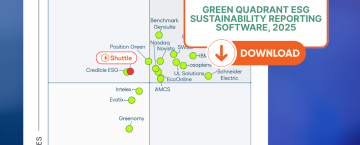Introduction
Faced with the growing demands of the CSRD (Corporate Sustainability Reporting Directive), the EU Taxonomy, and carbon accounting requirements, companies need to rethink their approach to sustainability reporting.
The interwoven regulations and the complexity of managing data call for a comprehensive and integrated method.
In this article, discover the 5 fundamental pillars of a successful sustainable transition, exemplified by kShuttle’s platform approach. These principles enable companies to turn regulatory challenges into strategic opportunities.
Check also the following replay from the dedicated workshop at Produrable (english subtitles available).
1. Specialty: Tailored modules for each regulation
Sustainability encompasses diverse regulations, each with its specific requirements. Specialization is at the core of an effective platform. At kShuttle, every module is designed to address a particular regulation, such as:
CSRD: Alignment with ESRS standards and management of reporting data.
EU Taxonomy: Handling eligible and aligned activities according to the six environmental objectives.
Carbon Accounting: Integration with GHG Protocol standards.
Thanks to this specialization, each module provides deep expertise and ensures full regulatory compliance.
2. Interoperability: Connected, fluid data
Companies collect data from various sources: financial tools, HR systems, environmental datasets, and more. A platform’s interoperability connects all these data sources in one place without duplication or data loss.
External Interoperability: Integration with ERP systems, accounting software, or specialized tools like EcoVadis and CDP.
Internal Interoperability: Smooth communication between modules, allowing data to flow without manual reprocessing.
This approach eliminates silos and simplifies centralization, offering a coherent view of sustainability performance.
3. Compliance: Always up to date with standards
The fast pace of regulatory changes, especially for CSRD and the EU Taxonomy, demands a platform that can remain continuously compliant. Companies must ensure their data is ready for stringent audits with features such as:
Built-in consistency checks to verify data accuracy.
Continuous updates to reflect the latest regulatory changes, like new versions of ESRS standards.
Compliance ensures reliable, audit-ready reports, enhancing credibility with stakeholders.
4. Scalability: A platform that grows with you
Every company progresses at its own pace in its sustainable transition. Scalability is essential to adapt to growing needs:
Add new indicators or entities as maturity increases.
Gradually integrate features such as carbon accounting or social data.
This flexibility allows organizations to address immediate priorities while preparing for future demands.
5. Specificity: A solution adapted to your reality
No two companies are the same. Specificity involves customizing the platform to reflect the unique operational needs of each organization:
Sectoral References: Integration of industry-specific requirements, such as alignment criteria in construction or transportation.
Local Compliance: Adaptation to national and international regulations.
This ability to adjust ensures a tailored experience, simplifying data management even for complex structures.
Conclusion
The challenges of sustainability reporting are numerous, but with an approach based on these 5 pillars, companies can transform obligations into strategic opportunities.
kShuttle’s platform approach addresses these issues through its specialty, interoperability, compliance, scalability, and specificity.
Share this article



